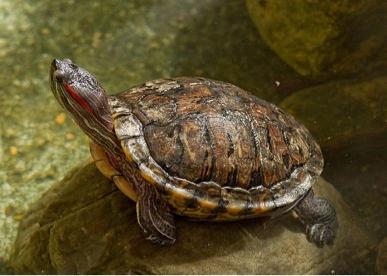Red-eared slider
-
Scientific Name
Trachemus scripta elegans - Visit ITIS for full scientific classification.
-
Description
 Red-eared slider turtle. © Greg Hume (commons.wikimedia.org)
Red-eared slider turtle. © Greg Hume (commons.wikimedia.org)- Medium-sized turtle.
- Can grow to 14.5 inches long.
- Distinguishable, thick red stripes on either side of the head, except in older males which often become darkened from the sunlight and can be hard to distinguish from the native Western Pond Turtle.
- Smooth shell.
- Rear edge of top shell is serrated (rear edge is smooth in native pond turtle).
- Olive brown color on skin and top shell.
- Often has yellowish spots or stripes, and a yellow colored bottom shell.
-
Habitat
- Wide range of freshwater habitats, both natural and man-made.
- Found in rivers, ditches, lakes, ponds, swamps, canals, etc.
- Prefers slow-flowing waters with a lot of vegetation.
- Often found near urban areas, including city park ponds.
-
Invasion Pathways and Distribution
- Popular pets.
- Introduced to new areas through release or escape from pet owners.
- Native to much of central and southern U.S.
- Invasive in California, Oregon, Washington, and many other states and countries.
- See USGS for a map of current U.S. distribution.
-
Life History
- Can live to about 20 years in the wild, and up to 50 years in captivity.
- Females dig nests in upland habitat near water bodies.
- Egg hatching depends on weather, and usually occurs during warmer temperatures (around 70-85 degrees F).
-
Impacts
- Extremely adaptable to different environmental conditions.
- Has a diverse diet, feeding on a wide variety of both plants and animals.
- Outcompetes native turtles for food, basking sites, and egg-laying sites.
- Can also transfer diseases and parasites to native turtles (Western Pond Turtle).
-
References and Useful Links
For references by category and links to other useful AIS sites see our Learn More page.

